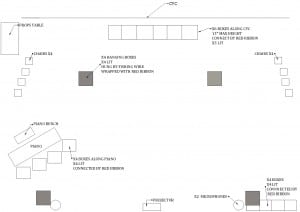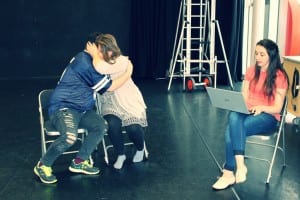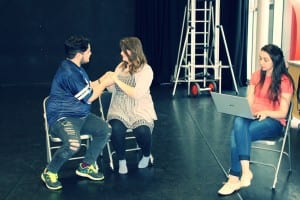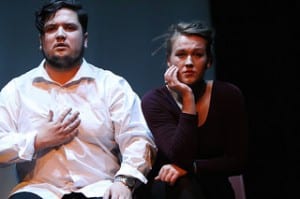We have been extremely busy at Fill In The Blank with a show almost ready! Because we have been working so hard on creating the performance I can revisit the Ground plan with a more concrete idea of what the show feels like. It is one of the benefits of being the set designer and a performer. I am always up to date with the staging/ blocking and the director’s intentions. When anything changes in a rehearsal, I am already aware. The design has changed rather dramatically since our last meeting. After our work in progress with fellow colleagues we took on board many more ideas. New ground plan shown below.
For the second draft of the ground plan that will go into the Stage Manager’s book, instead of a hand drawn sketch I used the software Sketch Up/ Layout. This meant I could measure height width and the length of the set if I needed to. It also allowed meant that the different pieces of set looked more concise and professional. From this the stage manager can see what is needed for the tech rider which shall be handed to the venue in advance of our technical rehearsal and our get in on show day. This ground plan also came with a preliminary props list to assist the SM and ASM with any health and safety necessity that should be flagged for the risk assessment.
Item Description Source
| Book | Placed upstage centre during scene then moved downstage left not moved until final scene | Company Member- Hannah Thorpe |
| Veil | Placed downstage left, not moved until final scene | Company Member – Michael Woodhall |
| Necklace | Placed downstage left, not moved until final scene | Company Member – Kirsty Rice |
| Large Black Umbrella, Wooden Handle | Placed downstage left, not moved until final scene | Company Member – Katherine Copley |
| Shoes/Black Heels | Placed mid stage right next to Piano, moved downstage left until moved again and worn in final scene. | Company Member – Naomi French |
All other props are to be set in in the boxes in the pre-set so should not pose any risk. If this ground plan does not change after the next meeting my plan will be to create a 3D model so the production team, and staff at the venue will have a clearer picture of my design.
Hannah.




